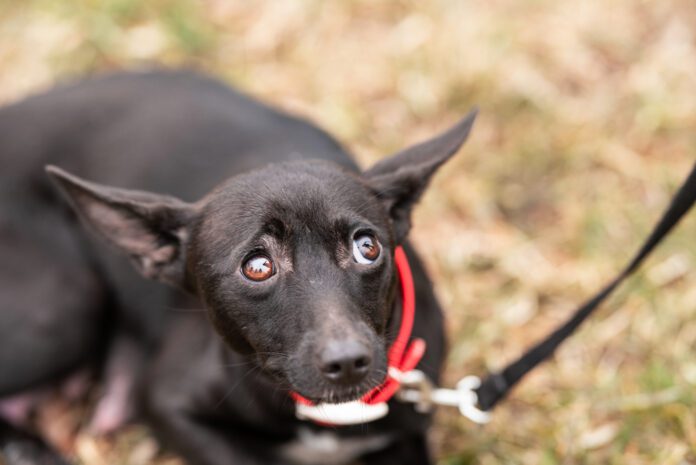Have you ever wondered if dogs can have panic attacks? Many pet owners are surprised to learn that our four-legged friends can experience sudden and overwhelming episodes of fear that look a lot like human panic attacks. If you dog has ever trembled, panted heavily, sweat from their paws, or frantically tried to escape for no obvious reason, you’ll understand how distressing it can be to watch.
In this article we’ll explore what a dog panic attack looks like, why it happens, and what you can do to help your dog feel safe and reduce their anxiety.
Can Dogs Have Panic Attacks?
In humans, a panic attack is defined as a sudden episode of intense fear that triggers severe physical and emotional responses (American Psychiatric Association, 2013). Although we don’t currently have a diagnostic framework available for dogs, we do see that dogs can exhibit similar episodes of acute distress.
Indeed, veterinary behaviorists and animal welfare researchers recognise that dogs can show signs of severe panic, especially related to noise phobias, separation anxiety, or post-traumatic stress disorder (Dreschel, 2010). These episodes often involve a sudden and extreme fear and/or anxiety response that overwhelms a dog’s ability to cope in the moment.
So, while there is no official veterinary diagnosis for dog panic attacks, dogs can certainly experience episodes of intense fear and anxiety that mirror human panic attacks.
Dog Panic Attack Symptoms
Recognising the signs that your dog is having a panic attack is the first step to helping your dog. Common symptoms of a panic attack in dogs include physical changes such as rapid breathing, dilated pupils, and raised heart rate (Beerda et al., 1997) and behavioural signs including pacing, excessive barking or whining, destructive behaviour, and attempts to escape.
Panic attacks in dogs differ from general anxiety in that they are intense and sudden. Anxiety may be present in the background, but a panic attack is like a sudden storm; overwhelming and often extreme. Dogs will typically not be interested in eating food or treats during a panic attack.
What Causes Panic Attack Symptoms in Dogs?
Panic attacks in dogs can have several different underlying causes. These include:
- Situational triggers like loud noises (e.g. fireworks, thunderstorms), car rides, vet visits, or confinement (Blackwell et al., 2013).
- Underlying anxiety disorders such as separation anxiety and noise phobias (Overall, 2013; Ogata, 2016).
- Medical issues like pain, neurological conditions, or thyroid disease (Mills et al., 2014).
- Genetic and developmental factors. Some dogs can be predisposed to panic attacks due to breed tendencies, a lack of early socialisation, or previous traumatic experiences (Tira & Lohi, 2014).
In short, some dogs are more prone to panic attacks due to a combination of genetics, past experiences, and the environment.
What To Do If Your Dog Has a Panic Attack
If your dog is having a panic attack the goal is to help relieve their fear and anxiety and help them feel safe. Practical steps include:
- Remain calm—this can be difficult but remember that dogs are sensitive to our emotional states.
- Provide a safe space—a quiet room, covered crate, or hiding spot can help when the trigger is occurring at home. If the panic attack is happening during a walk, try to create distance between your dog and the trigger by moving away out of sight.
- Soothing strategies—calming music or white noise can help drown out auditory triggers while pheromone diffusers or a pressure wrap can help reduce arousal.
- Offer comfort—being present can help however avoid excessive reassurance if it escalates your dog’s agitation.
- Distraction—food enrichment or treats (e.g. lick mats or chews) may help to distract your dog if their panic attack is not too severe.
- Avoid punishment—this can make fear and anxiety worse.
Medium- and Long-Term Management Strategies for Dogs with Panic Attacks
Knowing what to do when your dog has a panic attack is important in the short term, however medium and long term management and training strategies will help to reduce the duration, frequency and intensity of panic attacks in dogs:
Lifestyle Support
Lifestyle strategies such as maintaining consistent routines, ensuring your dog is getting adequate physical and mental exercise and enrichment, and staying in more predictable environments can help minimise anxiety and reduce stress.
Behaviour Modification
Desensitisation and counterconditioning—gradual exposure to triggers paired with positive experiences (e.g. treats, praise and play)—can help change the dogs underlying emotional response to the trigger (Levine et al., 2007). In addition, relaxation training and pattern games can help to promote calmer behaviour, especially in the presence of triggers.
Complementary Aids and Professional Help
If your dog is having panic attacks, getting a veterinary consultation to rule out a medical issue is important. If no relevant medical conditions are found, a referral to a veterinary behaviorist or certified applied animal behaviorist is a good next step.
Medications such as SSRIs, tricyclic antidepressants or anxiolytics may be recommended by a vet for severe or frequent panic attacks (Overall, 2013). Calming supplements, pheromones (e.g. Adaptil), and weighted/pressure garments can also be worthwhile additions to help reduce stress and anxiety.
The goal of medium- and long-term strategies is to improve your dog’s ability to cope with fear and anxiety caused by the trigger of their panic attacks and, ultimately, stop them from occurring.
Prognosis for Dogs Who Have Panic Attacks
So, can dogs have panic attacks? Yes, they can experience sudden and overwhelming episodes of fear and anxiety that look very similar to those experienced by humans. The good news is that with the right support, management, behaviour modification, and sometimes veterinary support, most dogs can improve significantly.
If your dog shows panic attack symptoms, don’t wait. It’s important to seek guidance from your vet or qualified behaviour professional. Helping your dog through panic isn’t just about reducing their fear in the moment, it’s about building long term resilience and trust through a consistent, kind, and positive approach.
References
American Psychiatric Association. (2013). Diagnostic and statistical manual of mental disorders. American psychiatric association.
Beerda, B., Schilder, M. B., van Hooff, J. A., & de Vries, H. W. (1997). Manifestations of chronic and acute stress in dogs. Applied Animal Behaviour Science, 52(3-4), 307-319.
Blackwell, E. J., Bradshaw, J. W., & Casey, R. A. (2013). Fear responses to noises in domestic dogs: Prevalence, risk factors and co-occurrence with other fear related behaviour. Applied Animal Behaviour Science, 145(1-2), 15-25.
Dreschel, N. A. (2010). The effects of fear and anxiety on health and lifespan in pet dogs. Applied Animal Behaviour Science, 125(3-4), 157-162.
Levine, E. D., Ramos, D., & Mills, D. S. (2007). A prospective study of two self-help CD based desensitization and counter-conditioning programmes with the use of Dog Appeasing Pheromone for the treatment of firework fears in dogs (Canis familiaris). Applied Animal Behaviour Science, 105(4), 311-329.
Mills, D., Karagiannis, C., & Zulch, H. (2014). Stress—its effects on health and behavior: a guide for practitioners. Veterinary Clinics: Small Animal Practice, 44(3), 525-541.
Ogata, N. (2016). Separation anxiety in dogs: What progress has been made in our understanding of the most common behavioral problems in dogs?. Journal of Veterinary Behavior, 16, 28-35.
Overall, K. (2013). Manual of Clinical Behavioral Medicine for Dogs and Cats-E-Book: Manual of Clinical Behavioral Medicine for Dogs and Cats-E-Book. Elsevier Health Sciences.
Tiira, K., & Lohi, H. (2015). Early life experiences and exercise associate with canine anxieties. PloS one, 10(11), e0141907.






Your web site is horrible!!! Every time I try to log in to read an article or purchase something, I can never accomplish what I attempt. Logging in is impossible
Craig Harris, you beat me to it. They need to hire a 16-year-old, I’m sure he could fix it for them. Good content but badly presented.
Mike Gordon, Paradise CA 95969
I don’t ever have any trouble logging in and reading all the articles that I want to read.
I can login on my computer, but all other devices have me locked out. Password does not work and it takes me in circles. Please help with this login issue. Others are having it as well and there’s no place to contact WDJ directly.
me too! i can login but cannot buy anything, i have been told my email address isnt on the system, even though i can log in 🙁